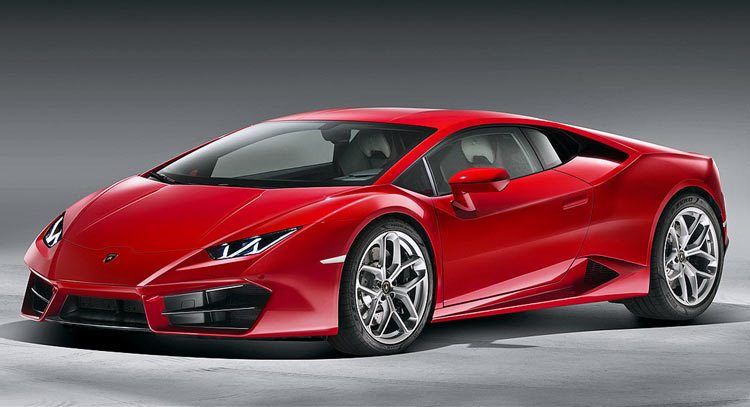The Lamborghini Gallardo LP 550-2 has an official successor; it’s called the Huracan LP 580-2 and it will be unveiled at the 2015 LA Auto Show on Wednesday.
The newest supercar produced in Sant’Agata Bolognese has dropped its all-wheel drive in favor of a “tail-happy” rear-wheel drive layout. Lamborghini also offers a new setup for the springs and anti-roll bars on double wishbone suspension, which improved the torsional stiffness of the Huracan LP 580-2 by 50 percent compared to the Gallardo LP 550-2.
Three different driving modes are available for the supercar, STRADA, for daily use, SPORT, for “emotional driving fun with slight oversteering behavior” and CORSA, which ensures maximum performance in track mode.
The exotic ride’s dry weight is now 1,389 kg (3,062 lbs), making it 33 kg (73 lbs) lighter than the four-wheel drive version. Weight distribution is 40 percent at the front and 60 percent at the rear while the stiffer suspension, new steering set-up for “more precise turning” and recalibrated traction and stability controls are also mentioned by Lamborghini.
The automaker also added the LPI (Lamborghini Piattforma Inerziale), a sensor placed in the model’s center of gravity, which traces all 3D movements, providing real-time info to the optional MRS (Magneto Rheological Suspension), steering and stability control systems.
A mid-mounted 5.2-liter V10 naturally aspirated engine is still found under its hood. However, this is now less powerful and it places the RWD Huracan in the same league as the McLaren 570S. The unit produces 580 PS (572 HP) and 540 Nm (398 lb-ft) of torque with 75 percent of that available from just 1,000 rpm, less than the LP 610-4, which has 610 PS (602 HP) and 560 Nm (413 lb-ft) of torque.
Cylinder deactivation technology was also implemented, just like in other Huracan models, meaning the Coupe and the Spyder, deactivating five of the ten cylinders when full engine capacity is not required. This reduces the fuel consumption to 11.9L/100km (20 mpg US / 23.7 mpg UK) and the CO2 emissions to 278 g/km.
Power is now sent to the rear wheels through the same seven-speed dual-clutch transmission as Lamborghini is still not offering a manual. The 0 to 100 km/h (62 mph) sprint comes in 3.4 seconds, 0.2sec slower than in the four-wheel drive model, while the RWD Huracan has a top speed of 320 km/h (199 mph), 5 km/h (3 mph) less than the AWD model. Power-to-weight ratio stands at 2.4 kg/hp, compared to the 2.33 kg/hp for the LP 610-4.
The exterior of the Huracan LP 580-2 has been slightly revised as it now has large front air intakes, directing the cooling air and headwind to increase pressure on the front wheels. A spoiler lip at the rear improves airflow, working together with the diffuser in the underbody. Lamborghini says that the rear-wheel drive Huracan doesn’t require a movable spoiler.
The steel brakes with aluminum disc calipers are covered by the 19-inch Kari rims (front / rear), which have been wrapped in Pirelli PZero tires, developed exclusively for the rear-wheel drive model.
The newest Lamborghini Infotainment System II, with a 12.3-inch high-res TFT instrument panel, is found in the cabin. The Lamborghini Huracan LP 580-2 is available with the entire range of colors and trims as the regular model and the Ad Personam personalization program adds “limitless” external and internal color combinations.
The supercar is currently available for order at dealerships across Europe, with a suggested pre-tax retail price of €150,000 (evidently, local taxes will push that price way up).









